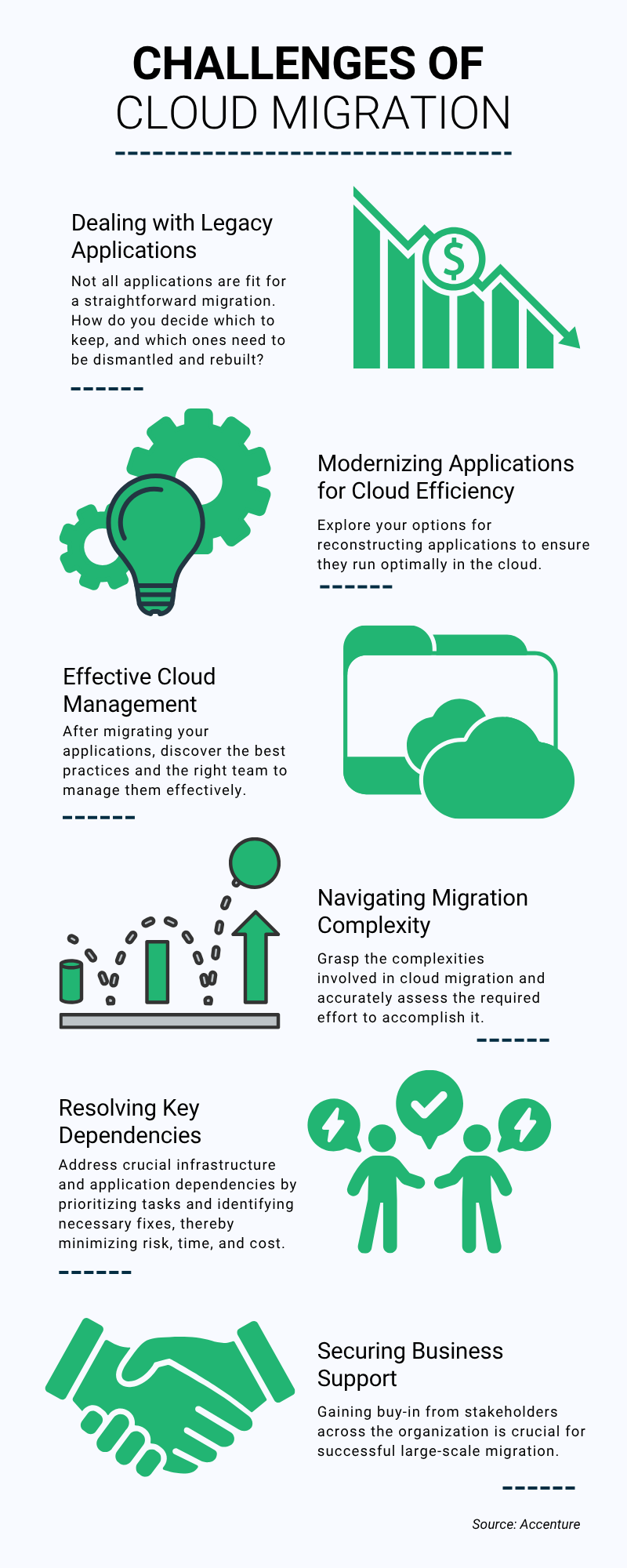Quick Summary: Cloud migration has become a defining priority for IT service firms; yet, many organizations continue to underestimate the strategic discipline required to execute it effectively. Effective cloud migration strategies demand precise workload evaluation, risk-aware planning, disciplined governance, and a long-term operating model that balances cost, performance, and resilience. Firms that approach cloud migration as a one-time infrastructure project often face spiraling expenses, service disruptions, and stalled modernization efforts. Those that treat it as a strategic transformation opportunity, however, can reposition their technology stacks for greater scalability, data visibility, and competitive advantage. This article examines the essential components of a modern cloud migration strategy—what works, what fails, and why forward-looking IT organizations are rethinking how they design, execute, and optimize migration at scale.
Cloud Migration Strategies: The High-Stakes Shift Reshaping IT, Costs, and Organizational Survivability
Failing to master cloud migration strategies could put your organization’s survival at risk in the digital age. Studies reveal that as cloud adoption accelerates, more than 45% of IT spending has already transitioned away from traditional technology toward cloud-based models.
The surge in connected devices has led to an explosive rise in data, prompting organizations to reassess how they store, process, and scale their digital environments. With affordability and agility becoming top priorities, more businesses are shifting toward cloud migration services. With 85% of companies now following a cloud-first approach as Gartner anticipated, the challenge remains that only three out of ten have clear visibility into their cloud costs, reinforcing the importance of strategic planning.
A well-structured cloud migration strategy guides the movement of applications, data, and infrastructure to the cloud. It identifies modernization needs, outlines migration steps, strengthens security, and improves scalability and performance. Projects play a central role in this shift. Every workload transition is a project with dependencies, timelines, risks, and resource demands. The quality of project planning has a direct impact on the success of migration outcomes.
This is where the AI-driven predictive project management solution can have a meaningful impact. They help organizations anticipate risks earlier, assess readiness, understand dependencies, and measure team alignment before issues surface. By providing teams with real-time insights, the solution enhances coordination, minimizes project delays, and facilitates more informed decisions regarding cloud migration. With the right approach and project intelligence, organizations can pursue cloud adoption with clarity, structure, and stronger results.
This article offers a clear and comprehensive overview of cloud migration strategies, enabling you to develop a structured roadmap and transition to the cloud with confidence. Before we go deeper, let’s take a closer look at what a cloud migration strategy truly involves.
What is a Cloud Migration Strategy
A cloud migration strategy is the plan organizations use to move their existing applications, data, and IT services to cloud platforms. This shift supports cost efficiency, enhanced security, improved agility, reduced end-of-life risks, data center consolidation, accelerated growth, and easier adoption of modern technologies.
Because every organization has different systems, workloads, and performance requirements, the migration journey varies for each individual. Not all workloads are suitable for the cloud, and each asset comes with its own level of cost, complexity, and business impact. To manage these differences, organizations build structured migration roadmaps that guide every step of the transition.
And with so much at stake in modern IT environments, the next logical step is to ask what drives this shift and why the cloud has become the strategic foundation for future-ready organizations.
If you’re ready to understand what truly sets successful cloud strategies apart, start your journey here. Explore TrueProject and discover how leaders create migration plans that actually deliver results.
Why Should You Migrate to the Cloud
Cloud adoption brings a wide range of benefits that support both day-to-day project operations and long-term business growth.
- Enhanced accessibility. Once applications and data move to the cloud, project teams can access them from any location with an internet connection. This supports flexible work, quicker decision-making, and smoother collaboration. For instance, IT service firms that migrate analytics workloads to the cloud enable teams to access dashboards instantly, thereby speeding up client reporting.
- Stronger disaster recovery. Cloud platforms provide reliable backup and recovery options by replicating project data across different regions. This reduces downtime, protects critical information, and improves business continuity. For example, healthcare organizations that migrate patient-management systems to the cloud experience faster recovery during outages, thereby protecting the continuity of care delivery.
- Global reach. With an extensive global presence, cloud providers enable organizations to expand into new markets without incurring significant upfront investments. Teams can easily support customers across regions. For instance, retail enterprises hosting e-commerce platforms in the cloud reduce latency for global shoppers and deliver a more consistent customer experience.
- Environmental sustainability. Cloud platforms reduce energy consumption and hardware waste compared to traditional on-premises systems. Moving to the cloud contributes to a cleaner, more sustainable technology footprint. For example, manufacturing companies shifting legacy ERP systems to the cloud cut down physical servers and lower carbon emissions.
And this is where the story shifts, because despite the apparent benefits, the journey to the cloud is riddled with challenges that continue to undermine even the most well-planned transformations.
Why Do So Many Cloud Migrations Fall Short Today
Cloud technology is reshaping how IT services operate, yet 90% of organizations remain concerned about security during migration. The market potential is massive. The cloud migration market is valued at USD 232.51 billion in 2024 and is projected to reach USD 806.41 billion by 2029. Despite this growth, many IT service providers struggle to meet rising expectations.
The core challenge is that traditional methods treat cloud migration as a technical shift instead of a broader business transformation. While 52% of companies have already moved much of their IT environment to the cloud, many fail to achieve the promised benefits. The reasons are clear. Initial assessments often overlook application dependencies and the key impacts on processes. Security efforts are not aligned with the unique risks introduced during transition. Change management receives limited attention, leaving project teams unprepared for new workflows and service delivery models.
As more than 50% of companies depend on Managed Service Providers for public cloud workloads, the pressure to improve execution continues to climb. Managed Service Providers are expected to work within ecosystem-based models that require stronger collaboration and more strategic approaches.
Understanding these gaps is the first step toward building migration strategies that deliver measurable value and long-term resilience.
These gaps set the stage for a deeper truth: the challenges holding back cloud migrations are more common and preventable than most leaders realize.
 Common Challenges of Cloud Migration Approach and How to Overcome Them
Common Challenges of Cloud Migration Approach and How to Overcome Them
Cloud migration brings clear advantages but also introduces challenges that can slow progress or create unnecessary risk. Below are the most common challenges and practical ways to address them.
1. Lack of Strategy: Many organizations rush into migration without a comprehensive plan. This leads to unclear priorities, poor workload selection, and unexpected disruptions.
How to overcome it: Define a clear roadmap that includes assessment, sequencing, and expected outcomes. Utilize a predictive project management solution to identify dependencies, forecast risks, and facilitate more effective coordination.
2. Cost Management: Cloud spend increases quickly when usage grows or services scale, and without the right KPIs, teams struggle to measure ROI.
How to overcome it: Set financial benchmarks before migrating and track them continuously. The AI-driven solution helps monitor cost trends, identify inefficiencies early, and guide optimization decisions.
3. Vendor Lock-In: Cloud providers offer services that are not easily transferred to another platform, making it difficult and expensive to switch later.
How to overcome it: Adopt a multi-cloud or hybrid strategy where possible. Favor portable architectures such as containerization and open standards.
4. Data Security and Compliance: Cloud migration introduces security risks during data transfer, configuration, and access management. Organizations must manage their share of responsibilities while ensuring compliance with relevant regulations and laws.
How to overcome it: Follow a security-by-design approach. Validate configurations, enforce access controls, encrypt data, and perform continuous monitoring with the help of predictive insights, which flag potential security gaps and support stronger project portfolio oversight.
Cloud migrations are often complex and fraught with risk. Beyond the challenges outlined, organizations frequently encounter obstacles when transitioning resources to the cloud. With the foundational steps covered, it’s time to explore what truly elevates a cloud migration from a successful project to a long-term strategic advantage.
Turn cloud challenges into controlled, confident execution. Discover more about TrueProject and learn how predictive intelligence enhances cloud initiatives beyond traditional execution.
How to Plan Cloud Migration Successfully
Transitioning to the cloud can transform your business. Begin by examining the entire cloud journey to identify the necessary capabilities and actions required for successful execution across cloud migration strategies.
1. Define Goals: Goal setting is crucial in cloud migration to ensure everyone is aligned. Goals should be documented, detailing the current infrastructure baseline and key performance indicators (KPIs) to measure success. This is especially critical for IT projects that rely on clear objectives and measurable outcomes.
2. Finalize Assets and Timeline: A thorough inventory of applications, data, services, and hardware is essential. Prioritize moving less-critical components first, followed by critical ones with adequate support. The strategy should outline the decommissioning process of the old system.
3. Use Pricing Calculators: Cloud costs can escalate quickly. Utilize AWS, Azure, and Google Cloud pricing calculators to forecast expenses and optimize your setup.
4. Implement a Disaster Recovery Plan: Ensure a robust disaster recovery plan (DRP) is in place, updated, and tested. A reliable DRP ensures that unexpected issues do not adversely affect project timelines and the cloud migration process.
5. Train Employees: Transitioning to the cloud requires employee training, especially when moving from legacy systems. Continuous training is necessary due to frequent updates from cloud providers.
6. Avoid Vendor Lock-In: Select a cloud vendor with a future-proof technology roadmap. Consider a multi-cloud strategy to leverage the best features from various providers and mitigate the risk of vendor lock-in.
7. Document Everything: Comprehensive documentation of goals, assets, strategies, cost analysis, testing, and training plans is essential. This serves as a reference for stakeholders and compliance audits.
8. Test and Measure Success: The cloud migration process concludes with thorough testing and decommissioning old components. Utilize the predefined KPIs to measure both short-term and long-term success.
9. Stay Updated: To fully benefit from the cloud, stay abreast of new features and updates from providers. Incorporate an update cycle into your cloud migration strategies.
10. Focus on Automation: Use middleware tools to automate processes where possible. Establish continuous integration (CI) and continuous delivery (CD) processes to keep pace with the rapidly evolving cloud environment. Automation streamlines projects, enhancing their efficiency and reducing manual workload.
These cloud migration strategies help ensure a smooth transition, cost efficiency, and long-term success, while supporting the specific needs of your projects. However, even the strongest migration approach is of little value unless you can measure its effectiveness. So, how do you truly know if your cloud journey is working?
Cloud Migration Strategies: Measuring Success with KPIs and Metrics That Matter
A strong cloud migration strategy depends on clear measurement frameworks that show both technical progress and business impact. Organizations need key performance indicators (KPIs) that reflect performance, cost efficiency, security strength, client experience, and operational improvements to get a complete view of success.
- Technical performance metrics focus on availability, uptime, response times, data transfer completion, and infrastructure utilization. These indicators demonstrate the effectiveness of the migration and identify areas that require attention.
- Financial performance metrics track cost savings, ROI timelines, and reduced operational expenses. IT service firms require these metrics to validate investments and demonstrate value to their customers.
- Security and compliance metrics include incident frequency, audit outcomes, vulnerability scores, and access control effectiveness. These insights are essential in a landscape where security concerns remain one of the most significant barriers to cloud adoption.
- Client satisfaction metrics measure retention, service quality, new service adoption, and feedback scores. These metrics reveal whether migration enhances client relationships or creates new friction.
- Operational efficiency metrics focus on productivity, delivery speed, and the adoption of automation. They help organizations determine whether the migration is enhancing internal processes and facilitating scalable growth.
Setting baseline values before cloud migration begins allows project teams to compare results accurately. Regular reviews ensure improvement opportunities are spotted early and the migration strategy continues to create meaningful value. Once you understand how to measure progress, the next step is to explore the new forces quietly reshaping the cloud landscape.
See the difference real predictive insight makes. Get a live demo and experience how TrueProject reveals risks, trends, and project realities long before they escalate.
What Are the Latest Trends in Cloud Migration
The cloud migration landscape is rapidly evolving as new technologies, operating models, and business expectations transform how IT service firms deliver value. Staying ahead of these changes ensures that today’s migration investments continue to support long-term success.
1. Artificial intelligence and machine learning integration is becoming a core requirement rather than an optional add-on. Predictive analytics, automated optimization, and intelligent workflows are now expected in modern cloud strategies. Firms should seamlessly integrate AI and ML capabilities into their service offerings and cloud migration roadmaps.
2. Edge computing and distributed cloud architectures are transforming how applications are deployed and managed across locations. These models support low-latency workloads and globally distributed operations. IT service firms must deepen their understanding of edge environments and develop skills that support the management of distributed cloud environments.
3. Sustainability and green computing goals are playing a larger role in cloud decisions as organizations aim to reduce their environmental impact. Cloud strategies should include energy efficiency assessments, footprint reduction plans, and environmentally conscious workload placement to help clients meet sustainability commitments.
4. Regulatory evolution and compliance requirements continue to change as industries adapt to cloud-centric models. Firms must stay informed about new mandates and ensure migration plans support continuous compliance, adaptable controls, and clear reporting.
Preparing for these trends positions organizations to deliver stronger cloud outcomes, create future-ready capabilities, and support clients with confidence. Now comes the pivotal question: how do you turn these emerging trends into a cloud migration approach built for the future?
Transform Cloud Migration into a Future-Ready Advantage
A meticulous and well-executed migration strategy is crucial to ensure your organization capitalizes on the immense benefits of cloud technology. Missteps in this journey can lead to significant operational disruptions, increased costs, and security vulnerabilities. However, your organization can achieve a seamless and secure transition with a detailed plan that includes defining clear goals, conducting a thorough asset inventory, effective cost management, and providing continuous employee training.
Utilizing modern solutions, such as predictive intelligence-based project management platforms, and staying current with cloud advancements will help ensure a successful migration, continuous optimization, and steady innovation. TrueProject, a SaaS-based strategic project intelligence solution powered by predictive AI, enhances cloud migration efforts by identifying risks weeks or even months in advance, allowing for proactive mitigation of potential issues that could impact timelines or budgets. By continuously analyzing project data and stakeholder input against key performance indicators, TrueProject provides leadership with clear, actionable insights that support informed decisions throughout the migration journey.
Its automated oversight, early warning capabilities, and real-time visibility help organizations manage complex cloud initiatives with precision, reduce disruptions, and maintain project stability at every stage. Embracing these strategies and the TrueProject solution positions your organization for long-term growth, stronger project outcomes, and greater resilience in the digital age.
Your cloud migration can’t afford surprises. Start with TrueProject Snapshot and see what lies ahead, long before it affects timelines, budgets, or outcomes.
Frequently Asked Questions: Cloud Migration Strategies
1. What is the typical timeline to implement cloud migration strategies in an IT service firm?
Most cloud migration strategies take 6–12 months for full execution, depending on the size of the environment, integration needs, data complexity, and compliance requirements. Large enterprises may require phased rollouts extending beyond a year for stabilization and optimization.
2. How do IT service firms protect client data during cloud migration?
They use end-to-end encryption, strict access controls, pre-migration backups, validation testing, and secure transfer protocols. Clear communication with clients about timelines and data-handling steps is essential for transparency and trust.
3. What are the most common failures in cloud migration strategies?
Typical failures include incomplete workload assessment, underestimating data dependencies, weak security design, poor change management, rushed timelines, and a lack of post-migration performance tuning.
4. How should IT service firms structure pricing for cloud migration strategies?
Pricing is typically based on the complexity of the assessment, data volume, migration approach, security requirements, application modernization needs, and the level of ongoing support or managed services required after the migration.
5. What certifications matter most for teams delivering cloud migration strategies?
Valuable certifications include:
- AWS Certified Solutions Architect
- Microsoft Azure Solutions Architect Expert
- Google Professional Cloud Architect
- CompTIA Cloud+
- Kubernetes Administrator (CKA) for containerized migration strategies
These build credibility and technical readiness.
6. How do hybrid cloud strategies impact client service delivery?
Hybrid cloud models increase flexibility and scalability but require strong integration frameworks, unified monitoring, and governance to ensure consistent service levels across on-premises, private cloud, and public cloud environments.
7. What role does automation play in cloud migration strategies?
Automation speeds up workload migration, reduces human error, improves repeatability, enables faster testing, and helps teams manage large-scale migrations without escalating operational costs.
8. How often should cloud migration strategies be reviewed or updated?
Firms should review their strategies quarterly and update them at least annually, based on new technologies, changing compliance requirements, and evolving client business priorities.






